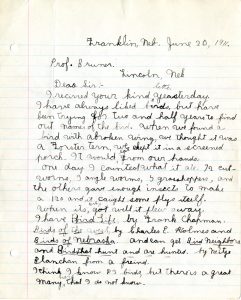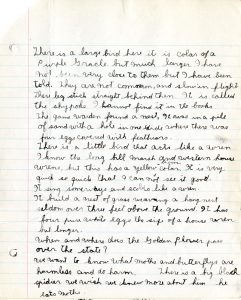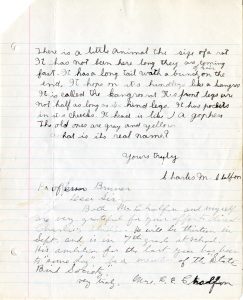Great Nebraska
Naturalists and ScientistsNOU, Charles M. Chalfron, Letter, 1911, June 20

Franklin, Neb. June 20, 1911.
Prof. Bruner. Lincoln, Neb.
Dear Sir –
I recived [sic] your kind letter. yeasterday[sic] I have always liked birds, but have been trying for two and half years to find out names of the bird. When we found a bird with abroken wing, we thought it was a Forster Tern, we kept it in a screened porch. It would eat from our hands. One day I counted what it ate. 72 cutworms, 9 angle worms, 5 grasshoppers, and the others gave enough insects to make a 120 and it caught some flys itself. When its, got well it flew away. I have Bird Life by Frank Chapman Birds of the West, by Charles E. Holmes and Birds of Nebraska. And can get Bird Neighbors and Birds that hunt and are hunted by Nelly Blanchan from a friend. I think I know 83 birds, but there’s a great many here that I do not know.
There is a large bird here it is colar [sic] of a Purple Gracle [sic] but much larger I have not been very close to them but I have been told. they are not common, and slow in flight. There leg stick straight behind then. It is called the skypoke. I cannot find it in the books. The game warden found a nest, It was in a pile of sand with a hole in one side where there was four eggs covered with feathers. There is a little bird that acts like a wren I know the long bill marsh and western house wrens, but this has a yellow- -brown colar. [sic] It is very quick so quick that I can not see it good. It sing someways and scolds like a wren. It build a nest of grass weaving a hang nest seldom over three feet above the ground. It has four pure white eggs the size of a house wren but longer. When and where does the Golden Plove pass over the state? We want to know what moths and butterflys are harmless and do harm. There is a big black spidier [sic] we wish we knew more about him. he eats moths.
There is a little animal the size of a rat It has not been here long they are coming fast. It has a long tail with a bunch of hair on the end. It hops on it’s hind legs like a kangaroo It is called the kangroo [sic] rat Its front legs are not half as long as its hind legs. It has pockets in its cheecks. It head is like a gophers The old ones are gray and yellow What is its real name?
Yours truly
Charles M. Chalfon
Professor Bruner
Dear Sir –
Both Mr. Chalfon and myself are very grateful for your offer to direct Charlie’s studies. He will be thirteen in Sept. and is in 7th grade at school. His ambition for the last year has been to “some day” be a member of the “State Bird Society.”
very truly, Mrs. C. E. Chalfon

